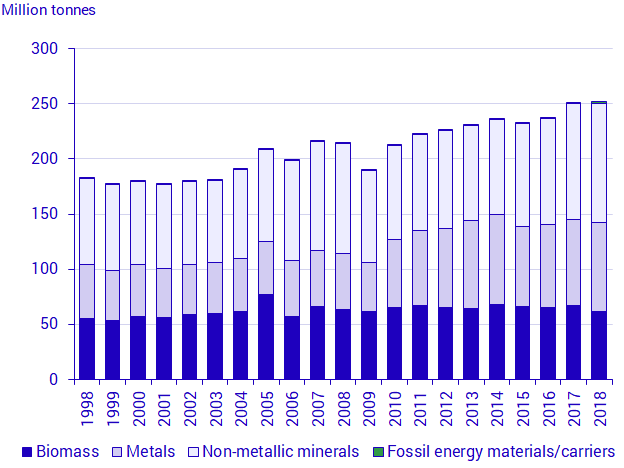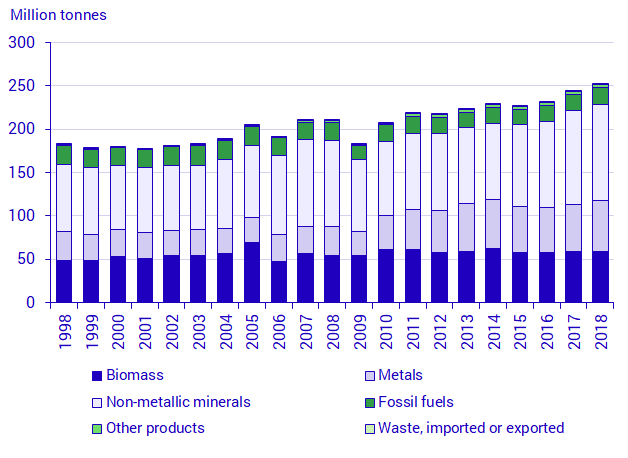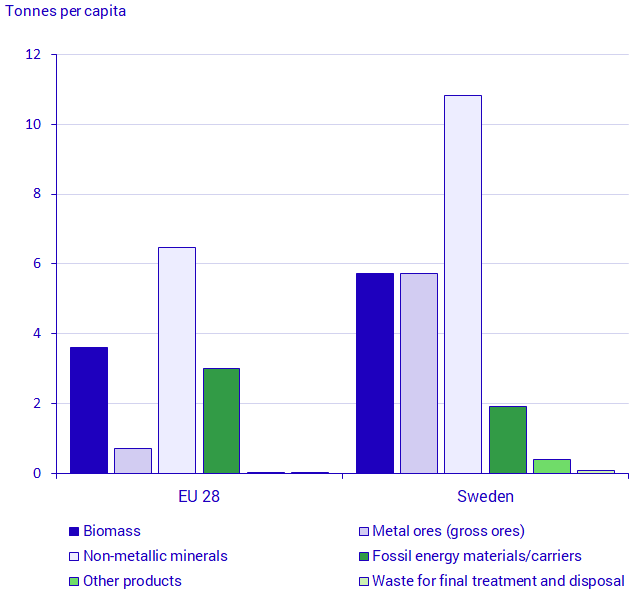Environmental accounts - Economy-wide material flow accounts 1998–2018
Drought slows the increase of Swedish extraction of natural resources
Statistical news from Statistics Sweden 2019-12-12 9.30
The rising trend in natural resource extraction, underway since 1998, slowed in 2018 as a result of a summer drought, followed by crop failure. In 2018, 252 million tonnes of natural resources were extracted in Sweden and material consumption also amounted to 252 million tonnes, which is 24.7 tonnes per person.
Domestic extraction
Significant quantities of natural resources extracted every year in Sweden are used domestically or are exported. In 2018, 252 million tonnes were extracted, which is the highest rate since the beginning of the time series in 1998. The earlier rate of increase slowed in 2018 due to crop failure, brought on by a summer drought.
Non-metallic minerals was the largest material category, with domestic extraction of 108 million tonnes in 2018, of which 99 million tonnes was sand and gravel. Extraction of metal ores amounted to 81 million tonnes in 2018, the most important of which were iron ore (36 million tonnes), copper ore (31 million tonnes), and gold and silver ore (10 million tonnes). In 2018, extraction of biomass amounted to 61 million tonnes, and consisted mainly of timber (39 million tonnes).
There is a rising trend in the extraction of non-metallic minerals and metal ores, which together increased by 6 million tonnes in 2018 (corresponding to a 3 percent increase). On the other hand, biomass extraction decreased by 6 million tonnes in 2018 (corresponding to a 9 percent decrease), leaving total extraction unchanged.
Certain events leave clear impressions in the statistics, such as the storm Gudrun, which led to a temporary large increase in timber extraction in 2005, and the international financial crisis, which led to a sharp decline in most categories in 2009 due to falling demand. The severe drought in the summer of 2018 also left a clear impression, as crops of cereals, pulses, oilseed crops and straw failed, which led to a drop in biomass extraction.

Source: Environmental Accounts, Statistics Sweden
Domestic material consumption
Domestic material consumption is defined as domestic extraction plus import, minus export. Total domestic material consumption has increased by 4 percent compared with 2017 and by 38 percent compared with 1998, and amounted to 252 million tonnes in 2018. Domestic material consumption of non-metallic minerals (that is, mostly sand and gravel), was 111 million tonnes in 2018, up by 2 percent compared with 2017 and by 43 percent compared with 1998. Consumption of metals has increased by 77 percent compared with 1998 and by 9 percent compared with 2017, amounting to 59 million tonnes in 2018. Consumption of biomass was 59 million tonnes in 2018, which is unchanged compared with 2017 and an increase of 21 percent compared with 1998. Consumption of fossil fuels has increased by 9 percent compared with 2017 and has decreased by 12 percent compared with 1998, amounting to 20 million tonnes in 2018. Consumption of fossil fuels was at its lowest in 2009 and in 2013–2015. The “other products” and “waste” categories have increased considerably compared with 1998, albeit from low levels. In 2018, consumption of other products was 4 million tonnes, and waste amounted to 0.7 million tonnes.

Source: Environmental Accounts, Statistics Sweden
Sweden compared to the EU
Reporting material consumption per person makes it possible to make comparisons with other countries. In 2018, material consumption per person was 24.7 tonnes in Sweden, while the EU average was only 13.8 tonnes per person. This gap has increased since 2008, when domestic material consumption per person was 22.6 tonnes in Sweden and 16.3 tonnes in the EU.
In Sweden, material consumption per person in 2018 was higher for biomass (5.7 tonnes compared to the EU average of 3.6 tonnes), metals (5.7 tonnes compared to the EU average of 0.7 tonnes), non-metallic minerals (10.8 tonnes compared to the EU average of 6.5 tonnes), and the small categories “other products” and “waste”. On the other hand, material consumption per person of fossil fuels was lower in Sweden (1.9 tonnes) than the EU average (3.0 tonnes).
The differences in material consumption between Sweden and the EU average can be explained by the fact that Sweden has a large area and a relatively sparse population, which leads to higher natural resource use per person. In an international perspective, Sweden has large metal deposits. Forests cover a large part of Sweden’s area, and most of the forests are managed, which gives large quantities of timber. A large part of Sweden’s energy supply comes from hydropower, nuclear power and biofuels, which reduces the need for fossil fuels, compared with the EU average.
Sweden’s extraction of natural resources per person is higher than the EU average. Countries with limited natural resources tend to have higher import levels. This means that the level of domestic material consumption is lower because imported goods are often value added and weigh less than the original material. This may explain why the EU average is much lower than Sweden’s consumption level.

Source: Environmental Accounts, Statistics Sweden
Definitions and explanations
The consumption of natural resources can be monitored in the system of economy-wide material flow accounts (EW-MFA). One of the main indicators of the EW-MFA is domestic material consumption (DMC), which measures the amount of material extracted in the country, plus imports minus exports.
Material flows are divided into the following main material categories: biomass, metals, non-metallic minerals (mainly sand and gravel), fossil fuels, other products and waste. These are further divided into 40 subcategories.
The EW-MFA is used to measure the resource productivity of a country’s economy, and to examine the relationship between resource consumption and the GDP in comparisons between different countries’ environmental performance. For instance, the DMC indicator is used in the EU Roadmap to a Resource Efficient Europe (see link below).ince 2013, the EW-MFA has been included in the EU regulation on environmental accounts (see link below), which means EU Member States are obliged to report statistics on their material flows to the EU.
Information on domestic extraction, import and export by material category is available in the Statistical Database. A file containing basic data and more figures is also available for download on the product page (link under "More about the results" at the top of this page).
Next publishing will be
2020-12-11 at 09:30
Statistical Database
More information is available in the Statistical Database
Feel free to use the facts from this statistical news but remember to state Source: Statistics Sweden.
